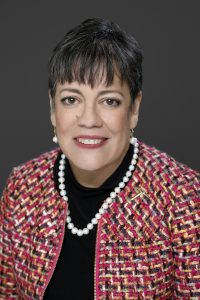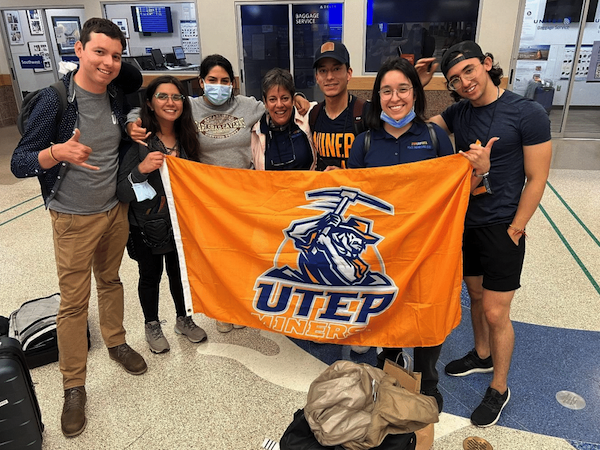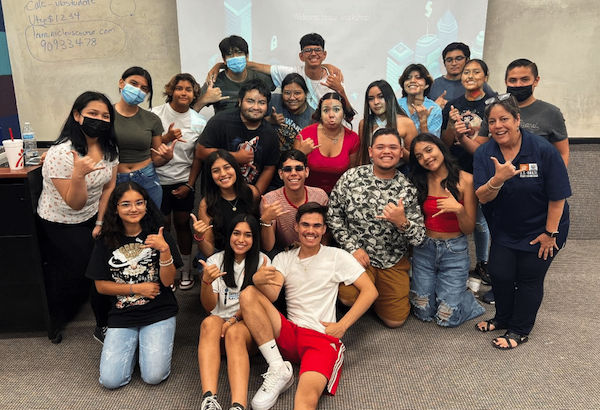ASEE CDEI Scholar Spotlight Series: Ivonne Santiago

Ivonne Santiago
Dr. Ivonne Santiago is an Associate Professor in the Civil Engineering (CE) Department at the University of Texas at El Paso (UTEP). Dr. Santiago has a combined experience of over 25 years in the areas of water quality, water treatment and wastewater treatment in Puerto Rico (PR), New Mexico and Texas. Dr. Santiago is passionate about providing experiential learning opportunities to both undergraduate and graduate students locally, regionally and internationally with a focus on Hispanic and female students. She is currently Co-PI of UTEP’s NSF H-AGEP program focusing on fostering Hispanic doctoral students for academic careers; the Department of Education’s (DoE) STEMGROW Program that encourages and supports Hispanic students and students with disabilities to pursue STEM careers; and YES SHE CAN that encourages and supports female students to pursue STEM careers . She is a member of two advisory committees to UTEP’s President: The Diversity, Equity, and Inclusion committee and serves as Chair of the Women’s Advisory Council. She is Co-Director of the National Science Foundation’s ASPIRE (Advancing Sustainability through Powered Infrastructure for Roadway Electrification) Engineering Research Center.
Tell us your story of belongingness
When I started my career in engineering, I was one of a handful of females in civil engineering. I always knew I belonged in engineering, and I was blessed to have studied at the University of Puerto Rico in Mayaguez (UPRM) that nurtured me and helped me thrive as a student. I went on to do my master’s and PhD at Clemson and New Mexico State and returned to teach at UPRM. I enjoyed my work and successfully went through the ranks to professor. I was successful. I had research projects, service in the government and loved teaching. Then my husband and I adopted a 10-year old child and decided to move to El Paso, Texas, to be close to his family for support. I took an academic break of four years to bond with my child. When I decided to come back to academia I was faced with a wall– I was told that the problem with me was that I had a hole in my resume, so I started at UTEP as a part-time lecturer. I have come a long way…not so much in position at UTEP, but in having my voice heard, and as advocate for students and for the engineering profession. My first lesson was: This is the land you have been given, “CONQUER IT”! I learned to give added value to my being an underrepresented female in engineering and due to the windy road that my career had taken because of sacrifices for our family, like so many other women.
But there is no such thing as a wasted experience! My experience helps showcase the windy path to success, and can convey an example to peers and other women of how we can still thrive. Where employers saw a gap, I saw a bridge. As difficult as those years were, they fundamentally changed me and how I see the world and my place in it. They were the proving grounds and source of strength that formed what drives me to succeed today, not just for personal gain, but for those lives I touch each day.
As I went into the world of engineering outside of my “student cocoon” I was faced with challenges that I was not prepared for. I was reminded of a phrase by Nakela Homer: “Behind every strong woman is a story that gave her no choice.” That is my story – a story I call “lectur-ella” alluding to Cinder-ella. I feel like a phoenix that rose from the ashes and 17 years after quitting my tenured professor position, I am now a tenured associate professor. I have no regrets in what I had to do. I only wish that I had had a mentor to show me how to do it better without committing professional suicide. This is why I am committed to providing mentorship to those female faculty that try to navigate a successful academic career with family.

With students on route to Colombia for faculty lead study abroad program.
Describe your understanding of DEI and why it is important to what you do.
Diversity, equity and inclusion is about two things: 1) Diversity fosters innovation. Our global challenges are complex and need different perspectives and skills to bring about the best solutions. 2) DEI is about fostering growth and providing the conditions for everyone to thrive, not just survive. As a civil engineer I always use the example of a ramp for people with a disability with my students. Does having a ramp take away the access to those that do not need it? No. Providing the tools and conditions for equity and inclusion does not take away from anyone but provides added value.
In a world that has become increasingly more biased against people because of where they are from, who they are, or their beliefs, more than ever it is indispensable to not only observe, but to do something about it. In the US alone, let’s think about what this means. If we did not include women, we would be missing out on the talent of about 50% of the population; if we did not include Blacks or African Americans, we would be missing out on the talent of 14 percent of the population; and if we did not include Hispanics, we would be missing out on the talent of 19% of the population. We must understand that everybody contributes and is valuable.
As an engineer I focus on equity in access to safe drinking water and transportation. Understanding that approximately 11 percent of the population lives in poverty in the USA (more than 30 million people), and they are as talented and intelligent as the rest of the poplulation – we are missing out on talent and opportunities for the future.

Dr. Santiago with pre-college students
What is one resource that you recommend to people who want to learn more about DEI?
Become part of a network like the POD or CIRTL that provide valuable information. Then of course, many professional organizations and centers of teaching and learning are creating communities that provide DEI resources.
What do you see as the next steps for your DEI work?
My next step is to continue learning and disseminating research-based information, and sharing my story to those interested so they can also thrive.
Who were your mentors and how did they help you?
I have had some “accidental mentors”, mentors that at the time did not realize the impact they had in my life. I have always said that I do not need 10,000 opportunities, I only need one. A couple of mentors come to mind that helped turn on the light to the door of success. Harry Meeuwsen former assistant provost at UTEP, gave me that opportunity as faculty fellow in teaching. Dr. Velez-Reyes gave me the opportunity to get involved in mentoring of Hispanic doctoral students and research opportunities. When someone believes in you, you start believing in yourself, and it begins a snowballing effect of empowerment that allowed me to see a future that I thought was unattainable. Other mentors have led by example, like the chair of my Civil Engineering Department Ismael Pagan, who taught me about the importance of vision and conflict resolution. And John Balliew, president and CEO of El Paso Water, who is still showing me about empathy leadership and how you can be a great leader with actions and few words.
What is your mentoring philosophy?
Be a good listener, let people be themselves and do not try to create them in your own image. Respect but don’t judge. Provide informational, emotional, appraisal support, and most of all, be an instrumental support that creates opportunities and opens doors for people. Help them discover their strengths and their path and help them navigate through their academic and professional career by providing them with the tools to nurture their success.
ASEE CDEI Communications Committee Volunteers
Volunteer Webmaster: Sarah Lester, California Polytechnic State University
Editor: Susan Boerchers
Getting involved with CDEI
- If you want to recommend someone for our Spotlight series click here.
- Check out website Highlights:
- Resources
- Past Blogs and Events
- Compilation of Newsletters and Reports
- Connect with the committee:
- Become a Friend of the Committee
- Follow us and tag us on Twitter
- Become a volunteer on our Communications Committee! We are always looking for people that want to share or improve their writing and leadership skills.

